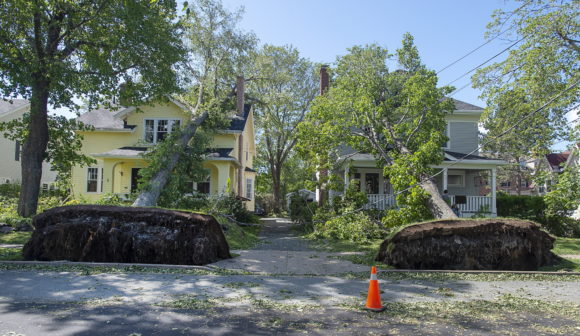Hurricane Dorian hit Atlantic Canada on Sept. 7 causing more than C$105 million (US$78.9 million) in insured damage, said Insurance Bureau of Canada, quoting the Catastrophe Indices and Quantification Inc. (CatIQ).*
The IBC noted that 70% of this amount is for damage to personal property, while 25% is for damage to commercial property with the remaining amount for damage to automobiles.
Hurricane Dorian wreaked havoc from the Bahamas to Atlantic Canada in early September. The weather system traveled through Atlantic Canada from Sept. 7 to 8, and the cleanup lasted much longer, said IBC in a statement. Halifax, Moncton and much of Prince Edward Island suffered a large portion of the damage, though damage reports were widespread across Atlantic Canada.
The IBC said initial estimates by province are:
- New Brunswick: C$22.5 million (US$16.9 million)
- Newfoundland & Labrador: C$2.5 million (US$1.9 million)
- Nova Scotia: C$62.2 million (US$46.7 million)
- Prince Edward Island: C$17.5 million (US$13.1 million)
- Quebec: C$300,000 (US$225,306).
On Sept. 7, Dorian became a post-tropical storm but maintained hurricane strength when it made landfall to the southwest of Halifax, with estimated sustained winds of 155 kilometers per hour (96 miles per hour). On the morning of Sept. 8, the system hit the northeastern Gulf of St. Lawrence with strong southeasterly winds in Newfoundland. In the evening, the system tracked to the northeast across Newfoundland’s Great Northern Peninsula, with wind gusts ranging from 90 to 157 km/h (56 to 98 mph).
Rainwater-saturated ground and trees in full leaf caused many large trees to be uprooted across Atlantic Canada, and the region had numerous power outages, said IBC. Heavy rainfall also caused road washouts and flooding of homes and businesses. The Magdalen Islands were severely affected as homes, cottages, and boats were damaged, and trees were uprooted; in several cases, and some cottages were blown off their foundations.
“Hurricane Dorian is another example of how devastating Mother Nature can be” said Amanda Dean, vice-president, Atlantic, IBC.
“Severe, unpredictable weather like this is becoming more frequent, resulting in higher costs to homeowners, insurers and governments,” added Dean. “Last year, insured damage from severe weather across Canada exceeded $2 billion, the fourth-highest amount of annual losses on record. That alarming trend has continued in 2019, with over $1 billion in insured losses recorded already this year.”
As the financial cost of the changing climate has been increasing, IBC said it has been working closely with all levels of government to increase investments to mitigate the future impacts of extreme weather and build resilience to its damaging effects. IBC is advocating for improved building codes, better land-use planning, incentives to shift the development of homes and businesses away from areas at highest risk of flooding, and investment in new infrastructure to protect communities from floods and fires.
Insurance Bureau of Canada (IBC) is the industry association representing Canada’s private home, auto and business insurers, with member companies making up 90% of the property and casualty (P&C) insurance market in Canada.
*The amount of insured damage is an estimate provided by CatIQ under license to IBC.
Source: Insurance Bureau of Canada
Photograph: Two fallen trees rest on neighboring houses in Halifax, Nova Scotia in the wake of Dorian, on Sunday, Sept. 8, 2019. The storm brought hurricane-force winds to Atlantic Canada, knocking out power to hundreds of thousands of people. Photographer: Andrew Vaughan/The Canadian Press via AP.
Was this article valuable?
Here are more articles you may enjoy.



 Carnival Puts Miami Headquarters Up for Sale as Florida Real Estate Soars
Carnival Puts Miami Headquarters Up for Sale as Florida Real Estate Soars  Cargo Owners in Baltimore Disaster Face ‘General Average’ Loss Sharing, MSC Says
Cargo Owners in Baltimore Disaster Face ‘General Average’ Loss Sharing, MSC Says  California Chiropractor Sentenced to 54 Years for $150M Workers’ Comp Scheme
California Chiropractor Sentenced to 54 Years for $150M Workers’ Comp Scheme  Coral Gables, Florida Tops Beverly Hills as Ritziest Home Market in US
Coral Gables, Florida Tops Beverly Hills as Ritziest Home Market in US 

